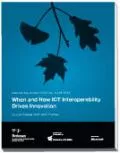The below case studies are part of an ongoing series developed in support of a larger text on interoperability by John Palfrey and Urs Gasser Interop: The Promise and Perils of Highly Interconnected Systems (Basic Books, June 2012).
The book is an extension of their 2007 study and paper, “Breaking Down Digital Barriers: When and How ICT Interoperability Drives Innovation” (Berkman Center Research Publication, 2007). Interop: The Promise and Perils of Highly Interconnected Systems focuses on the relationship between interoperability and innovation in the Information and Communication Technology (ICT) environment and beyond. Palfrey and Gasser seek to sharpen the definition of interoperability and identify its relevance for consumers, companies, governments, and the public by examining its driving forces and inhibitors, while considering how it can best be achieved, and why.
Authored by research assistants at the Berkman Center for Internet & Society in close collaboration with the authors, the series examines real-world examples where interoperability has played or continues to play a decisive role — in ICT and other sectors, including transportation, retail, and energy. Each case explores how forces such as law, policy, technology, economic incentives, and market innovations drive, or in some cases inhibit, interoperability, and what industry stakeholders seek to achieve via interoperability.
Some cases explore well-known innovations, such as the bar code and the UPC system, air traffic control, and the QWERTY keyboard layout. Others touch on more recent examples, including efforts to standardize cell phone chargers in the EU, the evolution of electronic data interchange systems, and digital rights management (DRM) systems. The nature of interoperability and its attendant challenges are also explored in less-traditional contexts, including commons-based knowledge creation models, which require large-scale collective efforts, and complex, next-generation models, like the Internet of Things, cloud computing, and the Smart Grid.
Interoperability Case Study: The Smart Grid
by Paul Kominers
Interoperability Case Study: The Bar Code/UPC
by Matthew Becker
Interoperability Case Study: Cloud Computing
by Matthew Becker
Interoperability Case Study: Electronic Data Interchange (EDI)
by Matthew Becker
Interoperability Case Study:Intermodal Containers and Global Cargo Transport
by Jacob Albert
Interoperability Case Study: Internet of Things
by Paul Kominers
Interoperability Case Study: EU Harmonization
by Félix Tréguer
Interoperability Case Study: Cell Phone Chargers
by Amy Rabinowitz and Seongmin Lee
Interoperability Case Study: From Crowdsourcing Potholes to Community Policing
by Manik Suri
